21/06/2021 at Copa America…that’s the last time Uruguay used a three-back system.
Nearly a year-and-a-half has passed since that game against Chile. That didn’t stop Diego Alonso from experimenting with the system in the FIFA World Cup group stage against the leaders and top seed, Portugal.
While it wasn’t a must-win scenario for Uruguay, a point would have put them clear of South Korea and within striking distance of both Portugal and their final group-stage opponent, Ghana.
Portugal’s 2-0 victory saw them join France and Brazil as the only nations to secure a spot in the knockout rounds after the first two games. Uruguay faces a very different reality. It’s win or go home for the South Americans. Worse, they may even need help from Portugal, who are sure to rest players during the match against South Korea.
How has Group H reached this stage? This tactical analysis looks specifically at Portugal’s victory over Uruguay. We’ll start with Uruguay’s 3-5-2 and how the match played out when that system was used. Portugal had more nervy moments in defence, which requires a detailed analysis. Finally, we’ll look at the impact of Uruguay’s return to the 4-4-2 midway through the second half.
Lineups
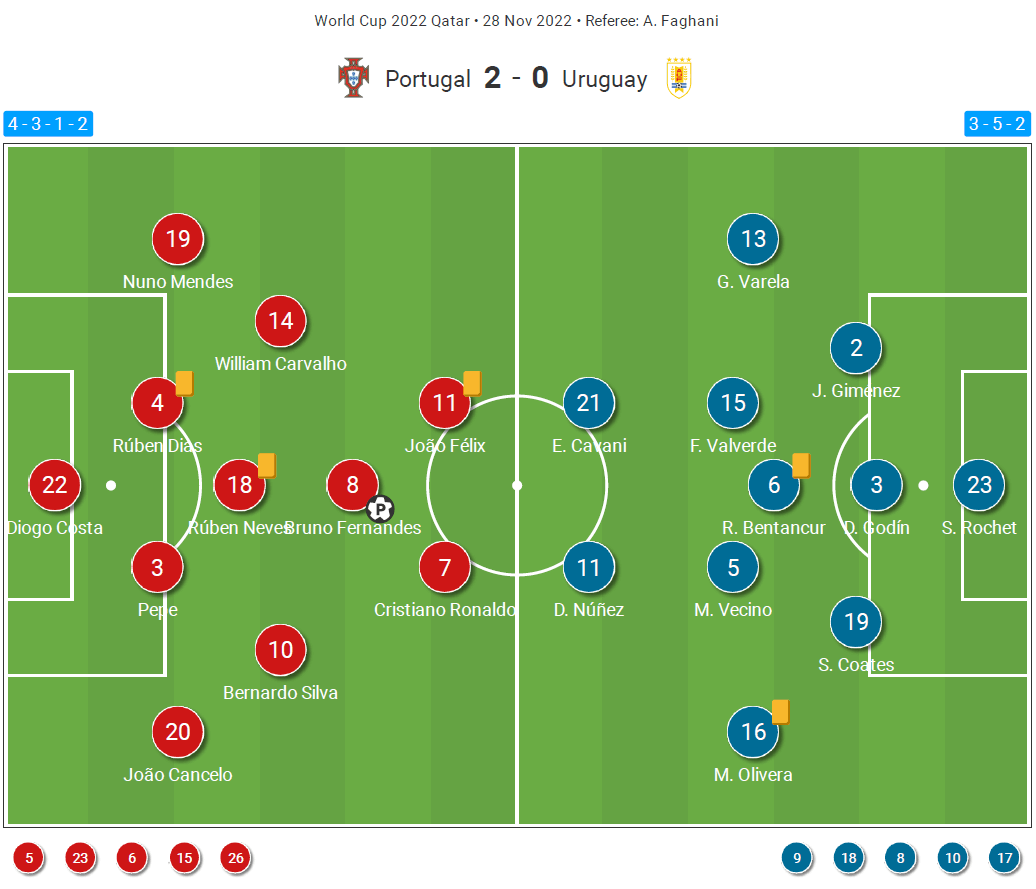
With Danilo breaking three ribs at last Saturday’s training session and Otávio dealing with an injury, Fernando Santos made rotations in this match. Pepe joined the starting eleven, becoming the third oldest field player in a World Cup match. William Carvalho, The Velvet Tank, replaced Otávio in midfield and PSG’s Nuno Mendes, nearly half the age of Pepe, made his World Cup debut in place of Raphaël Guerreiro. An injury would send the starlet to the dressing room early, leading to Guerreiro’s re-introduction to the lineup before halftime.
Everyone else kept their places. Diogo Costa made the start in goal with the Manchester City duo, Rúben Dias and João Cancelo, joining Pepe and Mendes along the backline. The very fluid diamond midfield included Rúben Neves, Bernardo Silva and Bruno Fernandes while João Félix and Cristiano Ronaldo started up top.
Alonso made three switches to go along with the move from a 4-3-3 to a 3-5-2. Sergio Rochet kept his place in goal while Sebastián Coates joined Diego Godín and José Giménez at centre-back. Mathías Olivera was the left-wingback while Guillermo Varela replaced Martín Cáceres on the right. The midfield remained unchanged with Rodrigo Bentancur, Federico Valverde and Matías Vecino. Liverpool’s Darwin Núñez who played in Portugal last season with Sport Lisboa e Benfica was the lone holdover up top from the previous match. Luis Suárez and Facundo Pellistri departed the starting lineup, making way for Edinson Cavani.
Portugal’s fluid attack vs Uruguay’s experimental back three
Perhaps watching Portugal’s match against Ghana convinced Alonso to make the change in system. With Portugal using a very fluid 4-4-2 formation with a diamond midfield, they routinely pushed two or three players into high central positions against Ghana and then used the outside backs to pin the Africans deep in their end. To counter Portugal’s high numbers, Alonso must have figured that a back five would give him protection against Portugal’s talented forwards and attacking midfielders, as well as stifle the Europeans centrally.
From a defensive standpoint, Uruguay did not concede many opportunities in the first half, especially in the first 20 minutes of the game. Their physical approach sent an early message to the Portuguese but didn’t necessarily rattle them. Portugal enjoyed much possession and routinely pinned the La Celeste deep in their end.
While Uruguay was in there 3-5-2, it was common to see three Portuguese attackers in high, central positions. As you can see in the image below, those three attackers occupied five Uruguayan defenders. That high positioning pinned the backline deeper down their end, leaving the forwards and midfielders to contain the seven remaining Portuguese players. With Uruguay’s numbers concentrated centrally, Portugal’s wingers found acres of space out wide. Ball progression through the wings was relatively easy for Portugal, but they found it difficult to create meaningful opportunities as they re-entered the centre of the pitch.
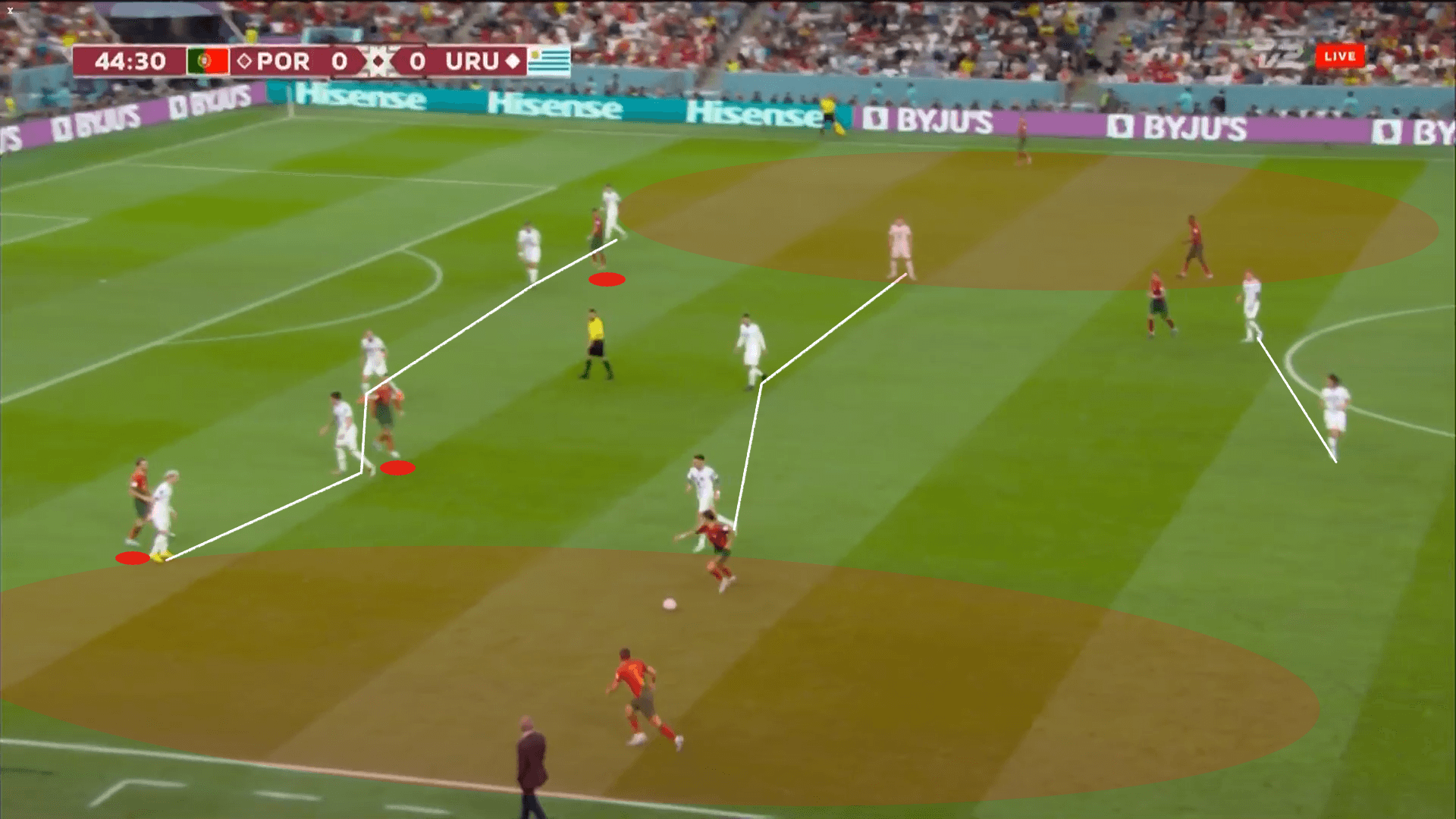
With Uruguay playing a 3-5-2, Santos knew he had to design his tactics to protect the centre of the pitch. Even though Portugal was very fluid in possession, their rest defence was generally very good. They had a few issues breaking Uruguay’s high press, but their in-possession shape let them quickly apply pressure on the first attacker. That’s exactly what happened with this Dias turnover. Silva was the closest man and quickly pressured Bentancur.
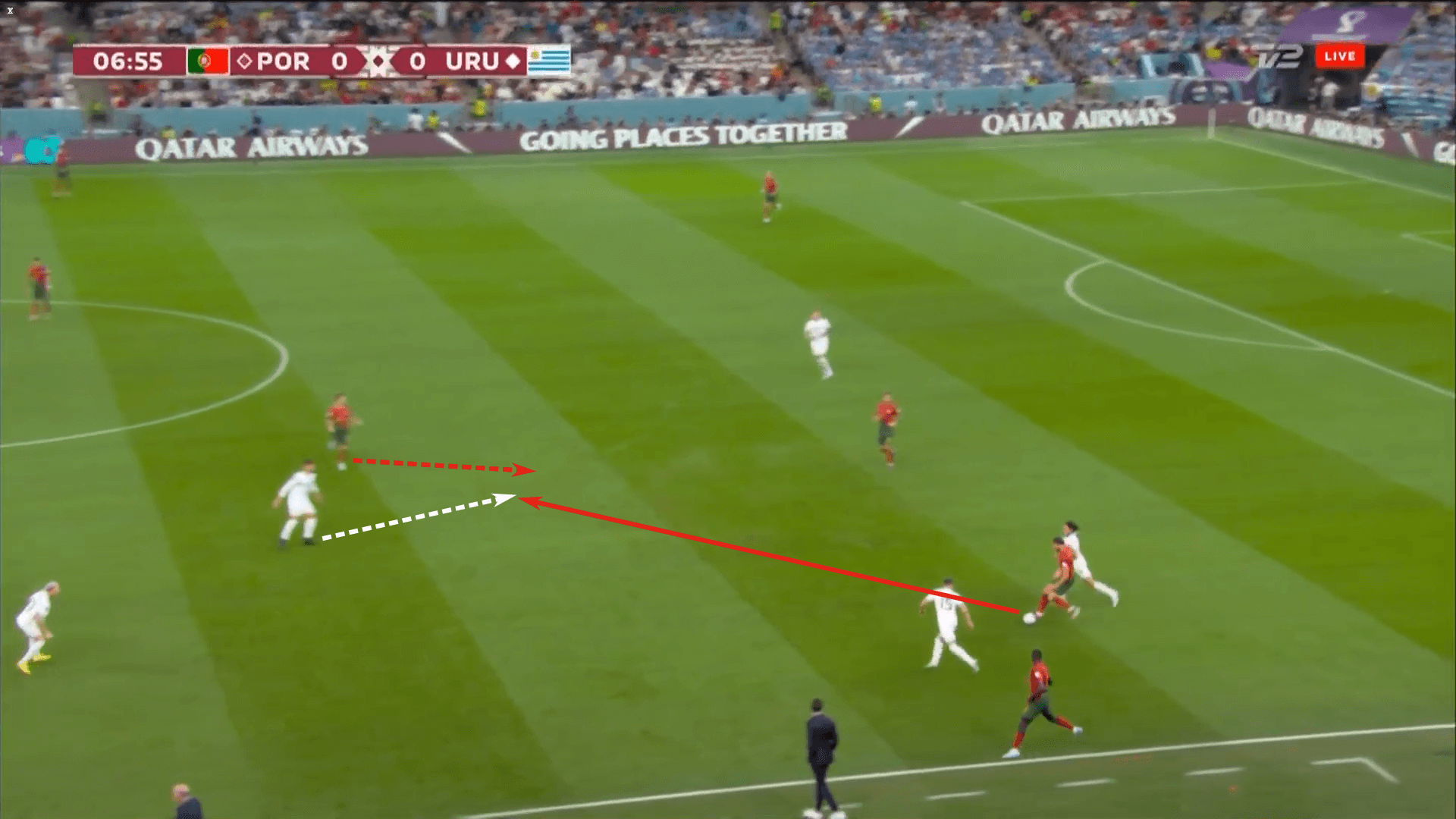
Has he engaged the Tottenham midfielder, Silva slowed him down enough to prevent him from playing forward right away, plus he allowed Pepe, Dias and Neves to recover centrally.
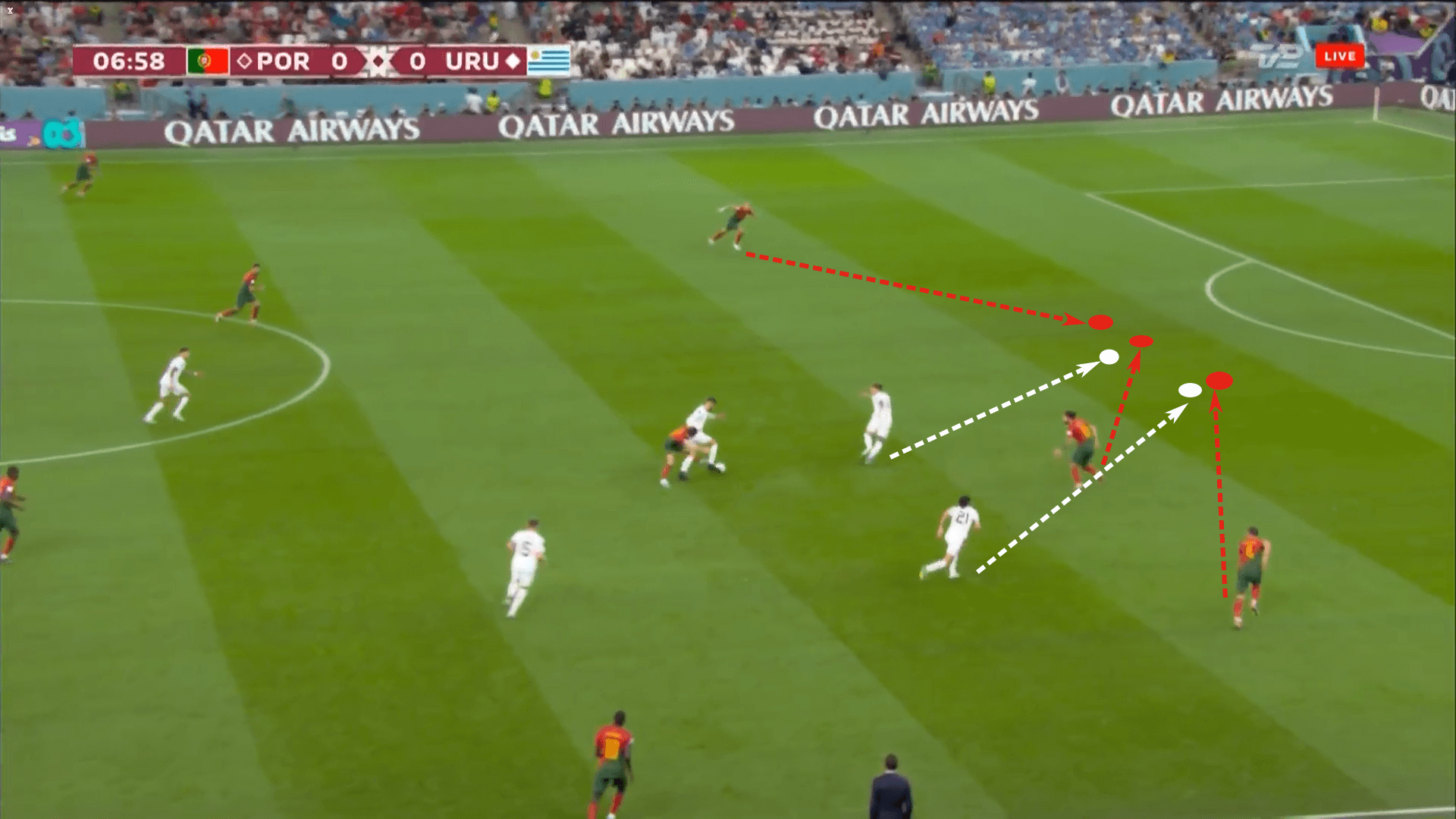
As Portugal progressed into the middle third of the pitch, their intent to dominate the centre was quite evident. Uruguay kept its three hard-working and defensively sound midfielders tightly connected, plus they received help from the two forwards, but it was clear they struggled to cope with Portugal’s exploitation of those central spaces.
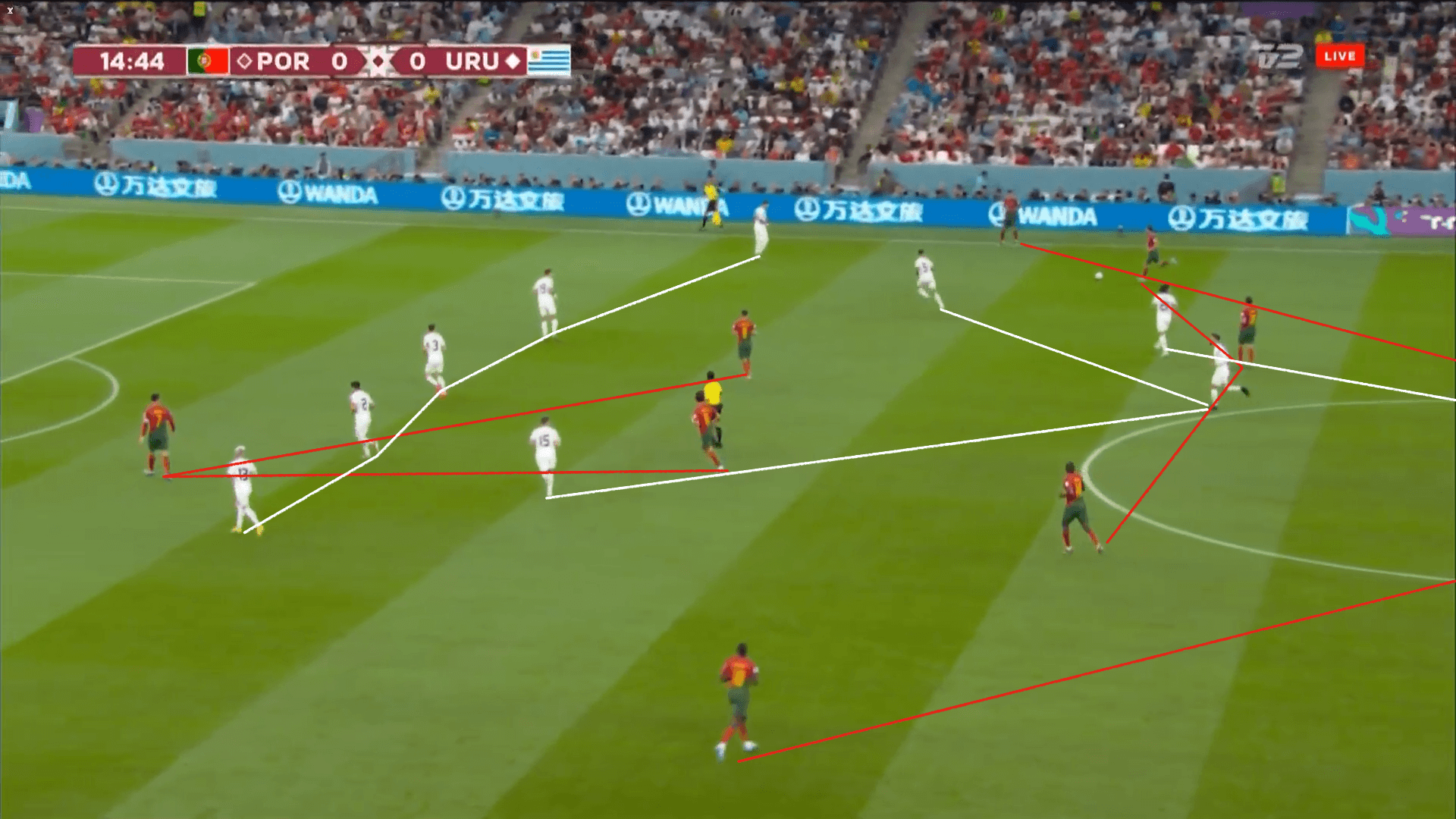
Below, we have a visual of Portugal engaging the Uruguayan mid-block. Eight of Portugal’s 10 field players are within the shaded red area that signifies the central channel. Only the two outside backs are outside of the shaded area. The central overload made it easier to play into the wings, but this sequence also gives us an idea of the space available between the lines.
The Portuguese did well to keep two or three players high up the pitch, stretching the backline to create space between the lines. Once that space opened up, they did well to exploit it, this time through a Dias pass to Fernandes.

When Portugal did attack through the wings, Uruguay’s midfielders were typically the ones to slide over and apply pressure. The combination of Ronaldo, Félix, Silva and Fernandes did well to drive the Uruguayan wingbacks deep into their end of the pitch. That created space for the Portuguese outside backs to attack on the dribble. As the midfielders closed that ground, space opened up centrally.
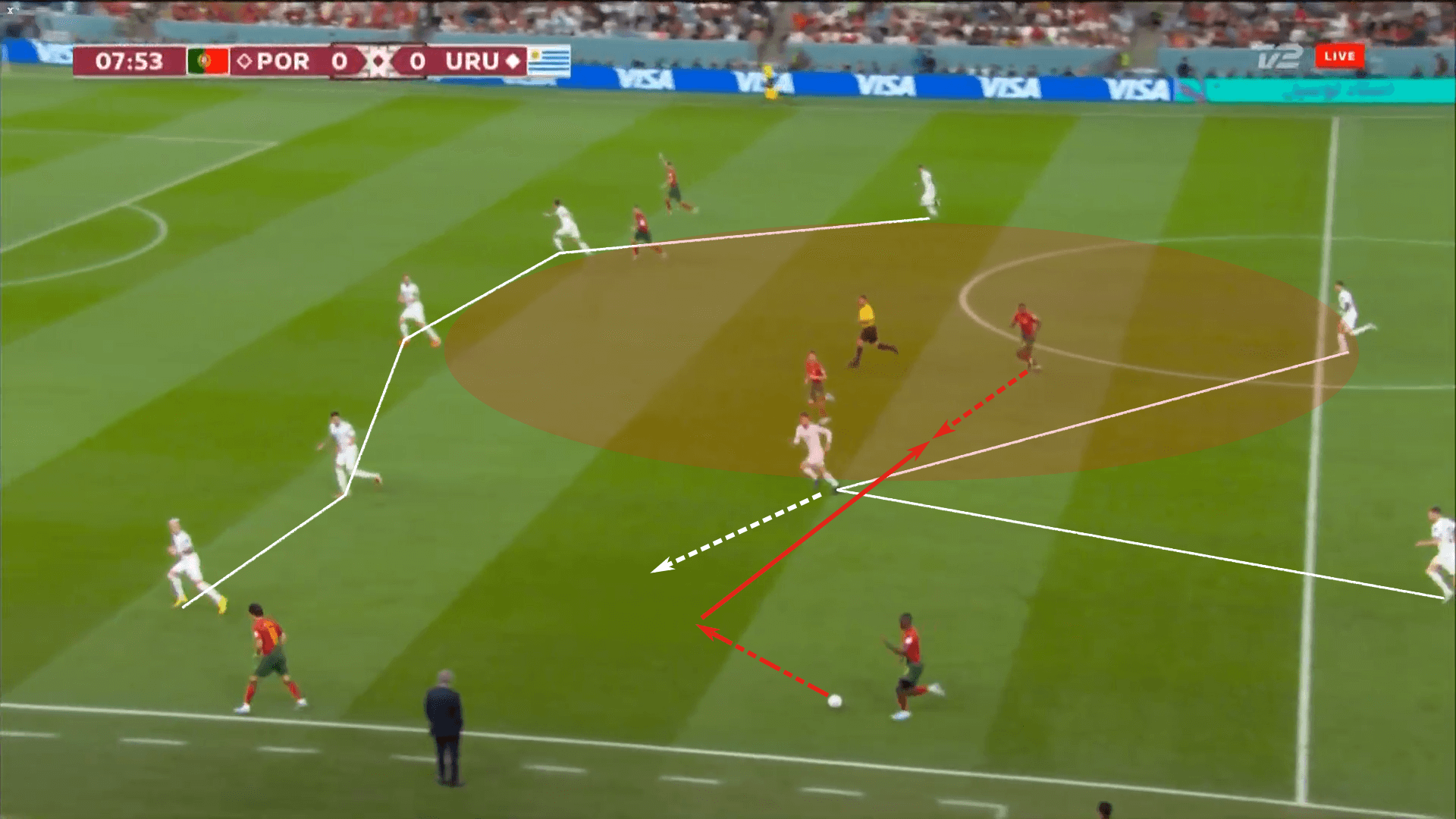
Though Uruguay came into this match with the hope of exploiting Portugal on the counterattack, just like they did in 2018, it was the South Americans who looked more vulnerable from a structural point of view. This pass from Pepe launched a Portuguese counterattack that led to a Félix shot that was deflected wide for a corner kick.
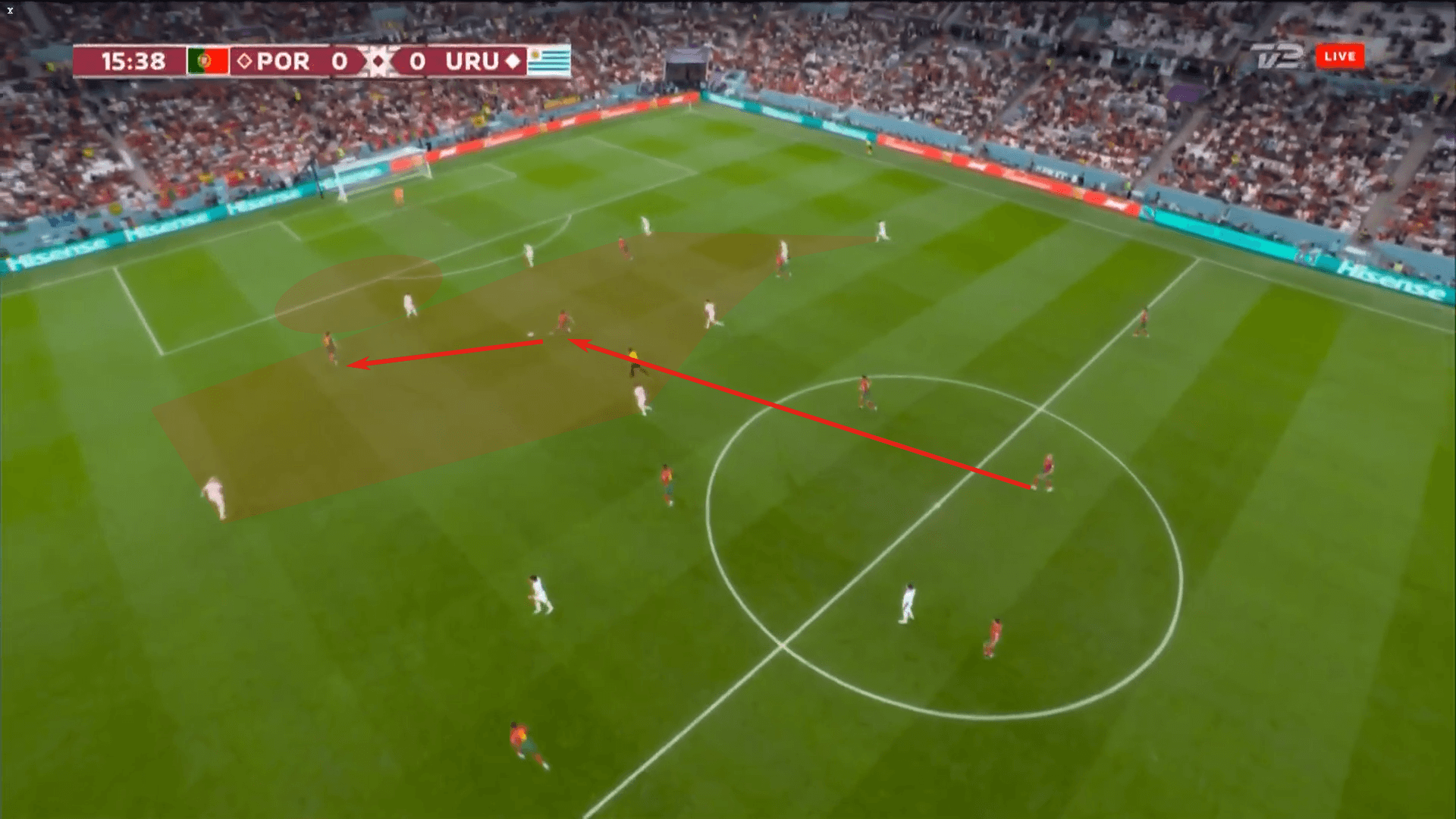
Despite having Núñez and Cavani up top, the South American side struggled to connect with their outlets up top. Furthermore, with the three midfielders and two wingbacks starting from deeper positions, they were often late to offer support. Then, if the ball was lost, the side was at risk of allowing line-breaking passes through the immense amount of space they were covering.
Uruguay did well to contain the Portuguese with some astute defensive third efforts, but their issues defending space in the high and mid blocks were routinely on display. With the Portuguese forwards and attacking midfielders dropping from the front line into the space between the lines, the three centre-backs were caught off guard throughout the match. This example from the 52nd minute shows Godín stepping into midfield to apply pressure on Silva, who bursts passed the veteran defender before playing Félix into the box.
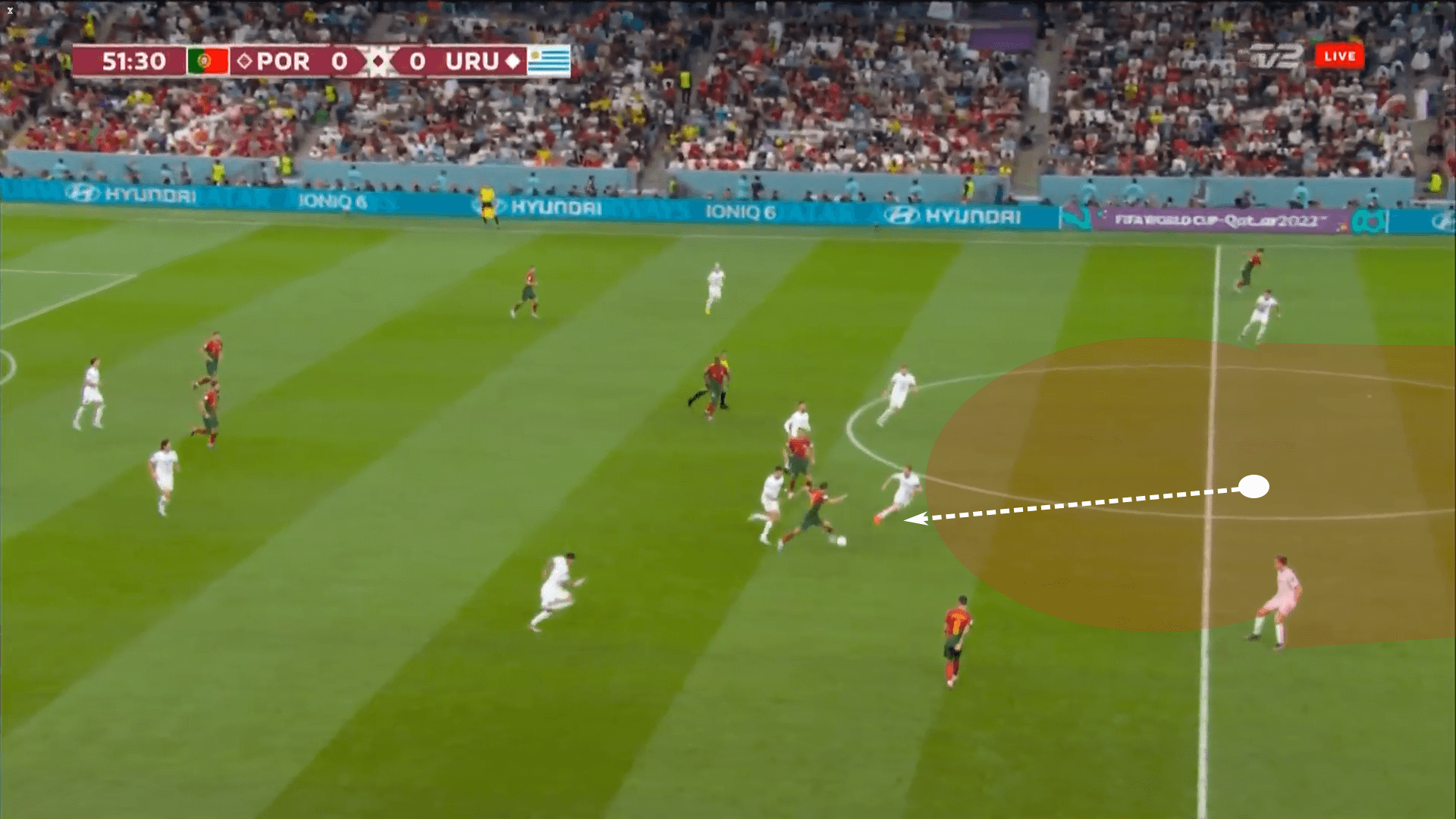
Uruguay struggled to produce many cohesive attacks in the first 60 minutes of play while in that 3-5-2 formation. The best chances came from Portuguese mistakes or moments of individual brilliance rather than an effective system of play. The lack of outlets hurt them in attack and the midfielders were required to cover too much ground defensively. Portugal benefited from La Celeste’s spacing but was unable to muster quality chances against Uruguay’s back five. It was 60 minutes of containment by the Uruguayans.
The good and the bad of Portugal’s defending
From a rest defence perspective, Portugal’s play was excellent. Much like the first half against Ghana, they were well positioned to counterpress and made it difficult for the opponents to play into the forward line.
In both games, Portugal’s defensive woes haven’t been structural so much as lapses in decision-making or technique. We’ve already discussed Santos’ emphasis on dominating the centre of the pitch. With Uruguay’s biggest threat coming on the counterattack, congesting the central channel and overloading near the ball would allow Portugal to quickly counterpress and seal passing angles to the outlets systematically.
This example from the 23rd minute gives a nice visual of Portugal’s central dominance. Neves wins the header, playing it out of the Uruguayan midfield network, but it’s Portugal’s numbers near the ball that simplify the job and allow them to restart their attack.
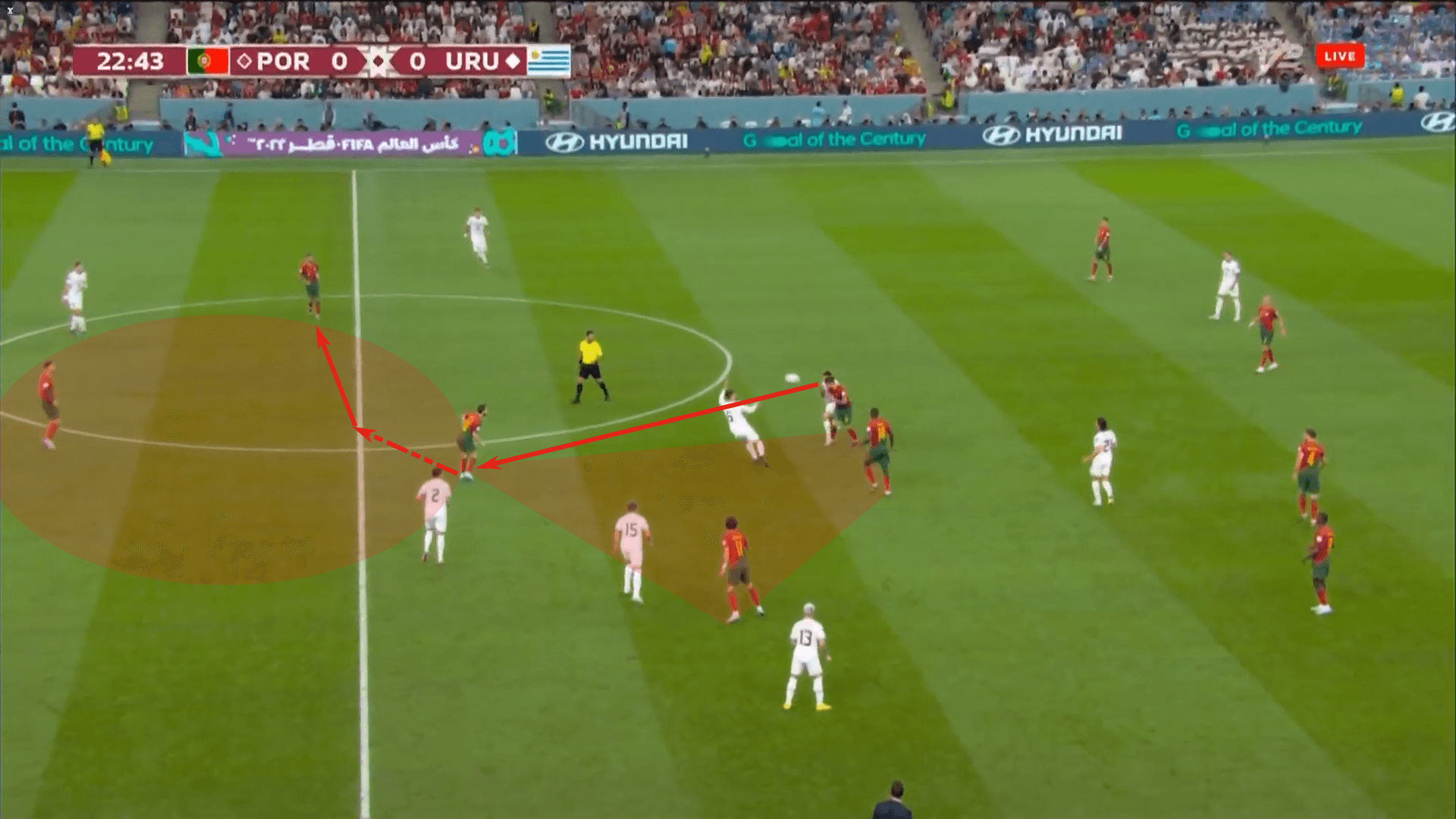
But this is a side that has had its issues at the back, both against Ghana and Uruguay. In general, Portugal has made it difficult for opponents to play through them. The issue is when teams can link up with that forward line and get numbers in support. Whether it’s a matter of the opponent’s midfield outmuscling Portugal’s or the second ball just happening to land at the opponent’s feet, A Seleção have had many nervy moments at the back. The goalkeeper, Costa, may very well have been the Man of the Match if not for Fernandes grabbing a second goal. The young Porto keeper made a few brilliant saves to keep the clean sheet.
Bentancur’s brilliant run in the 32nd minute came from a second-ball scenario. The ball moved beyond the two Portuguese midfielders and into the path of the Uruguayan. With the Portuguese backline dropping deeper to keep the first ball in front of them, a 20-yard gap opened up between the lines.
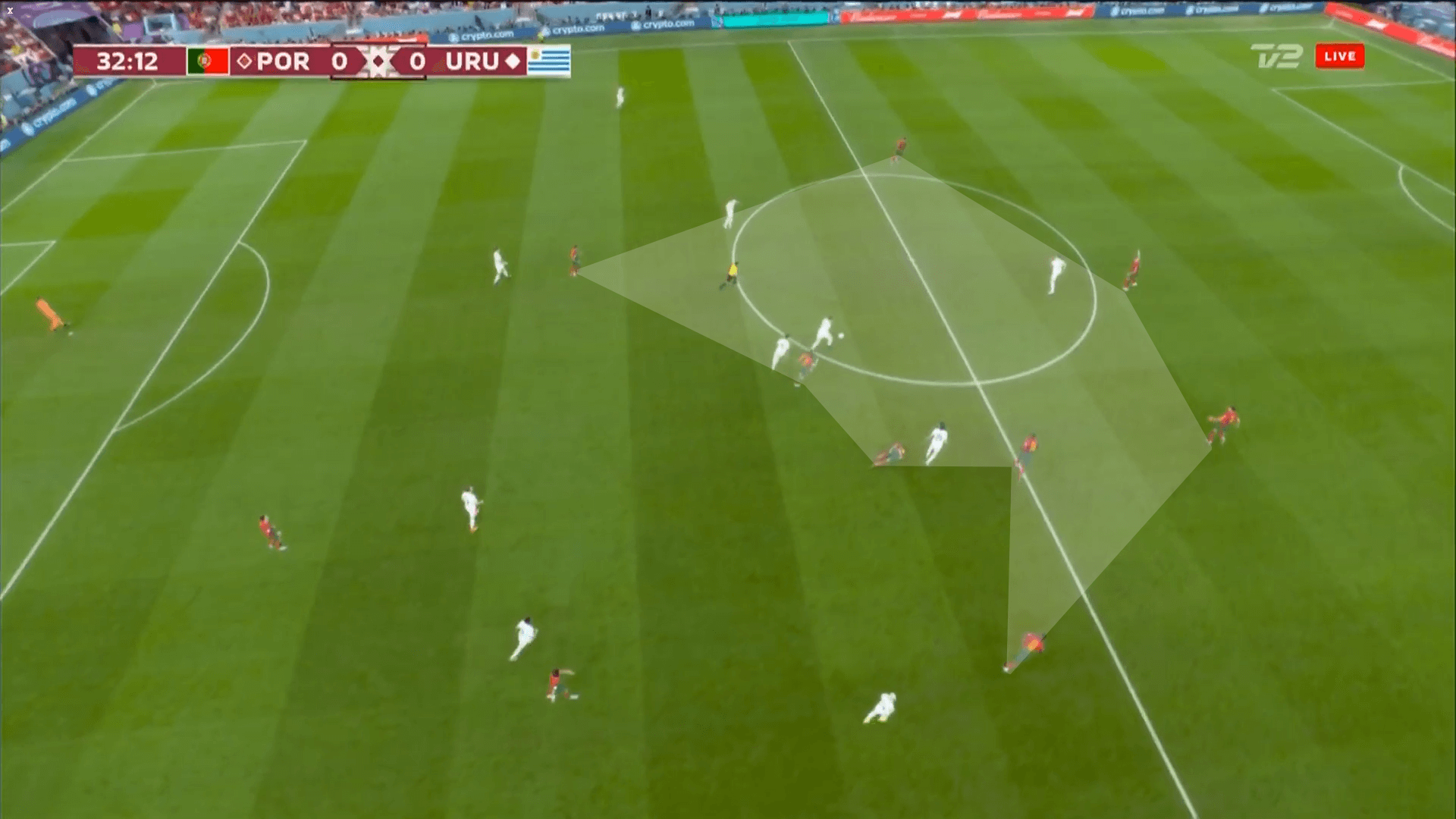
Carvalho managed to recover in time to help Dias and Pepe slid centrally to help. However, it was a moment of miscommunication between Dias and Carvalho that allowed the Tottenham midfielder to skip into the box and go 1v1 against Costa.
After the play, Dias appeared to gesture that he was trying to force Bentancur to the attacker’s right, which would have put him right into the path of Carvalho. However, the midfielder thought Dias was funnelling Bentancur into Pepe, the second defender on the play. Had he continued to funnel Bentancur towards his help, the odds of a blocked shot would have skyrocketed.
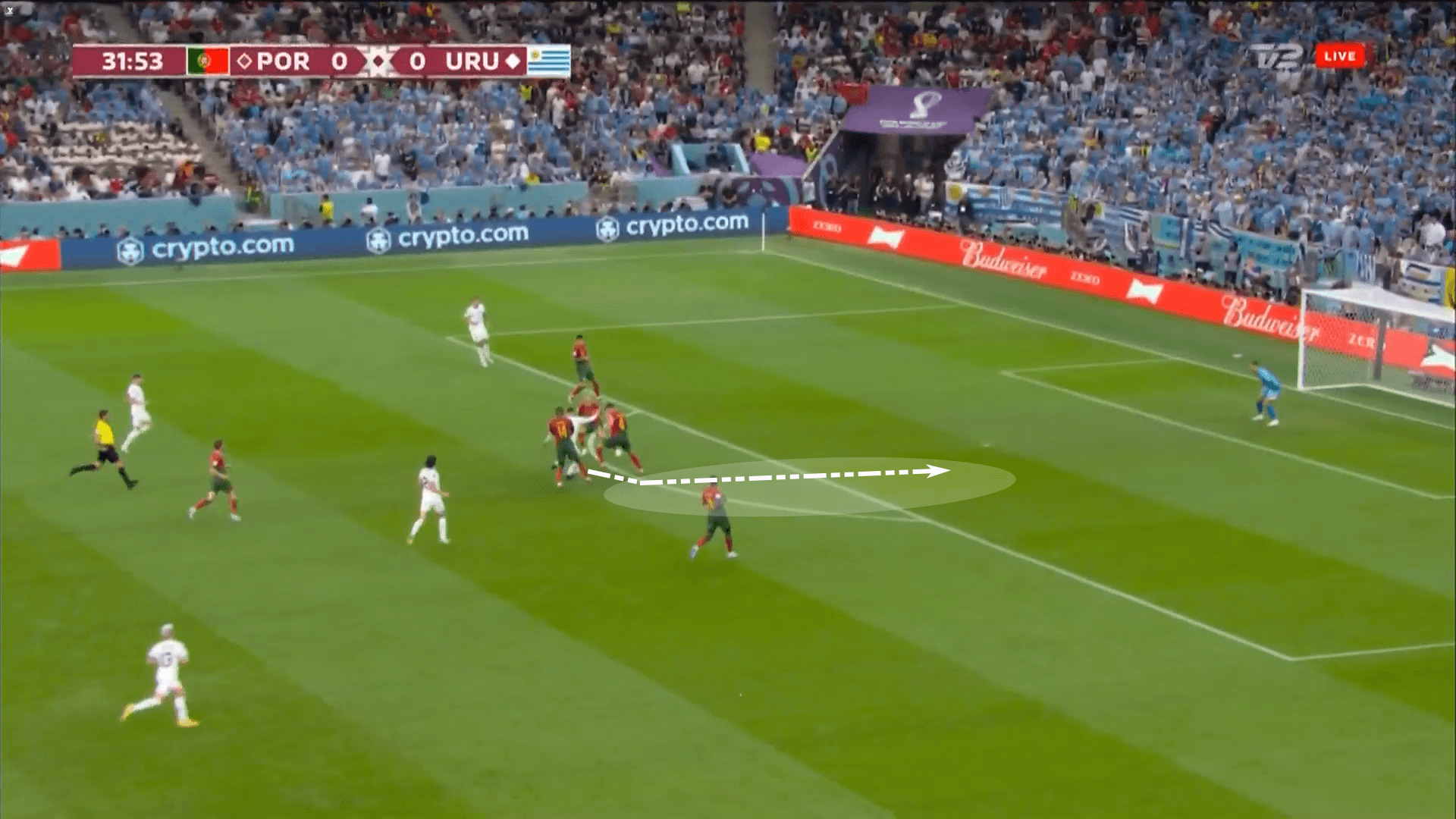
Instead, Carvalho was unprepared for the cut to the right and Dias stabbed at the ball, leaving him off balance and unprepared to run with Bentancur.
That wasn’t the first instance of poor tackling. Minutes later, Neves was the guilty party stabbing at the ball when he was the last midfielder protecting the backline. His loss in that duel, which again came at the hands of Bentancur, led to another decent chance at goal for the South Americans.
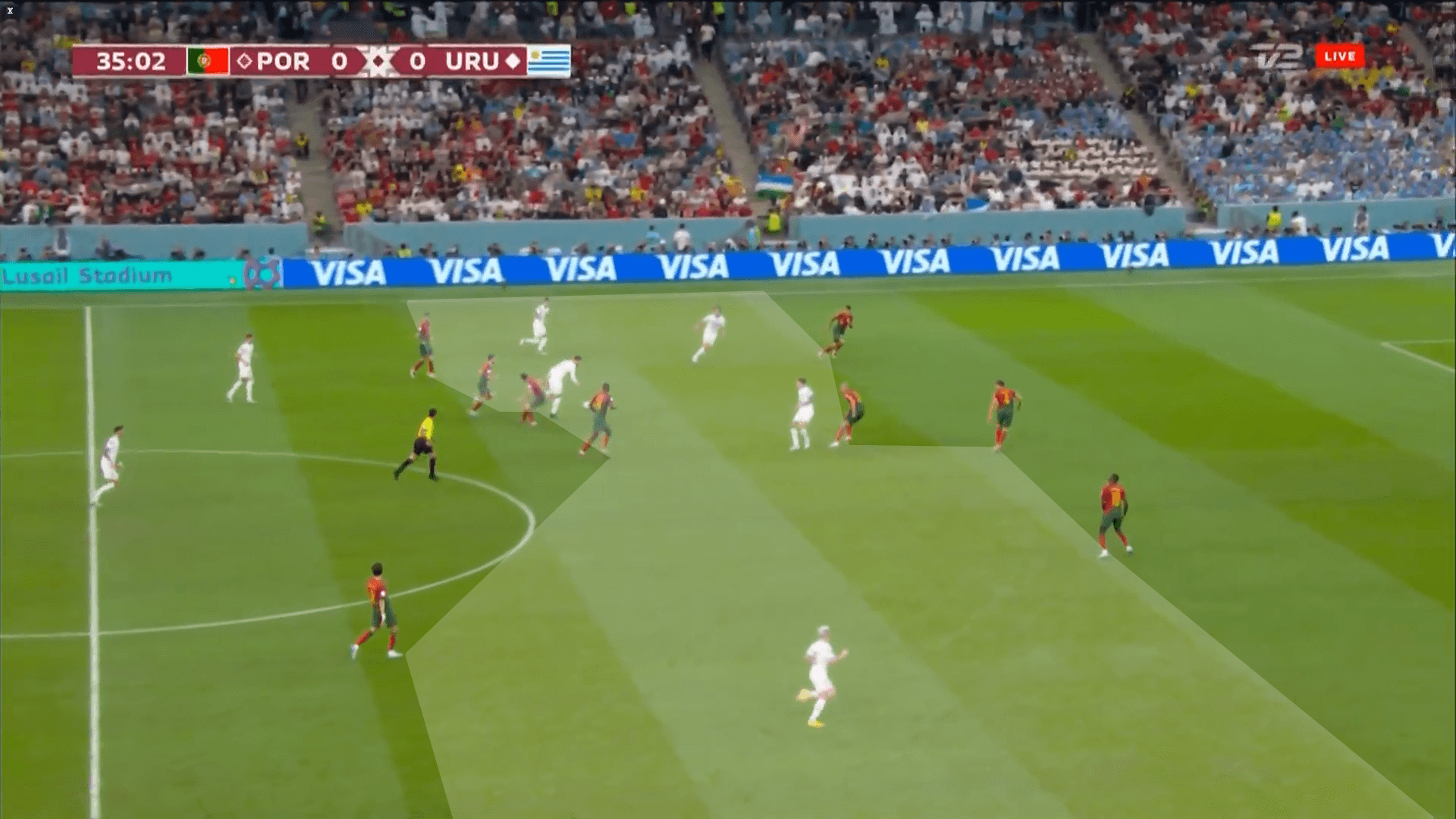
On the whole, even though Uruguay struggled to unlock the Portuguese defence in open attacks, analysis of the scoring opportunities afforded each team in the first half will tell you that the Uruguayans had the better chances and could very easily have gone into the locker room with a lead. Sloppy defending and poor decision-making hurt Portugal in the game against Ghana, but the Uruguayans weren’t able to make them pay in this one. In fact, they’re still searching for that first World Cup 2022 goal.
Reverting to the 4-4-2
Once Portugal went ahead and Uruguay continued to struggle with their open attacks, Alonso went to his bench and changed to a 4-4-2. That gave Uruguay the natural width they were lacking in the 3-5-2. For the first 65 minutes, the wingback struggled to get forward in support of the two forwards. By switching to a four-man midfield, Uruguay’s wingers now started higher up the pitch and were able to attack the spaces behind the Portuguese outside-backs, especially on the Uruguayan right side against Guerreiro.
With the wide midfielders pinning the Portuguese outside-backs deep in their own end, that created space for the Uruguayan outside-backs to drive forward in attack. In doing so, they forced the Portuguese frontline to drop deeper to support defensively. This was especially the case with Rafael Leão on the Portuguese left. With Portugal in more of a 4-3-3 from the moment of Leão’s entry, the AC Milan star was routinely forced to drop deep and chase Varela.
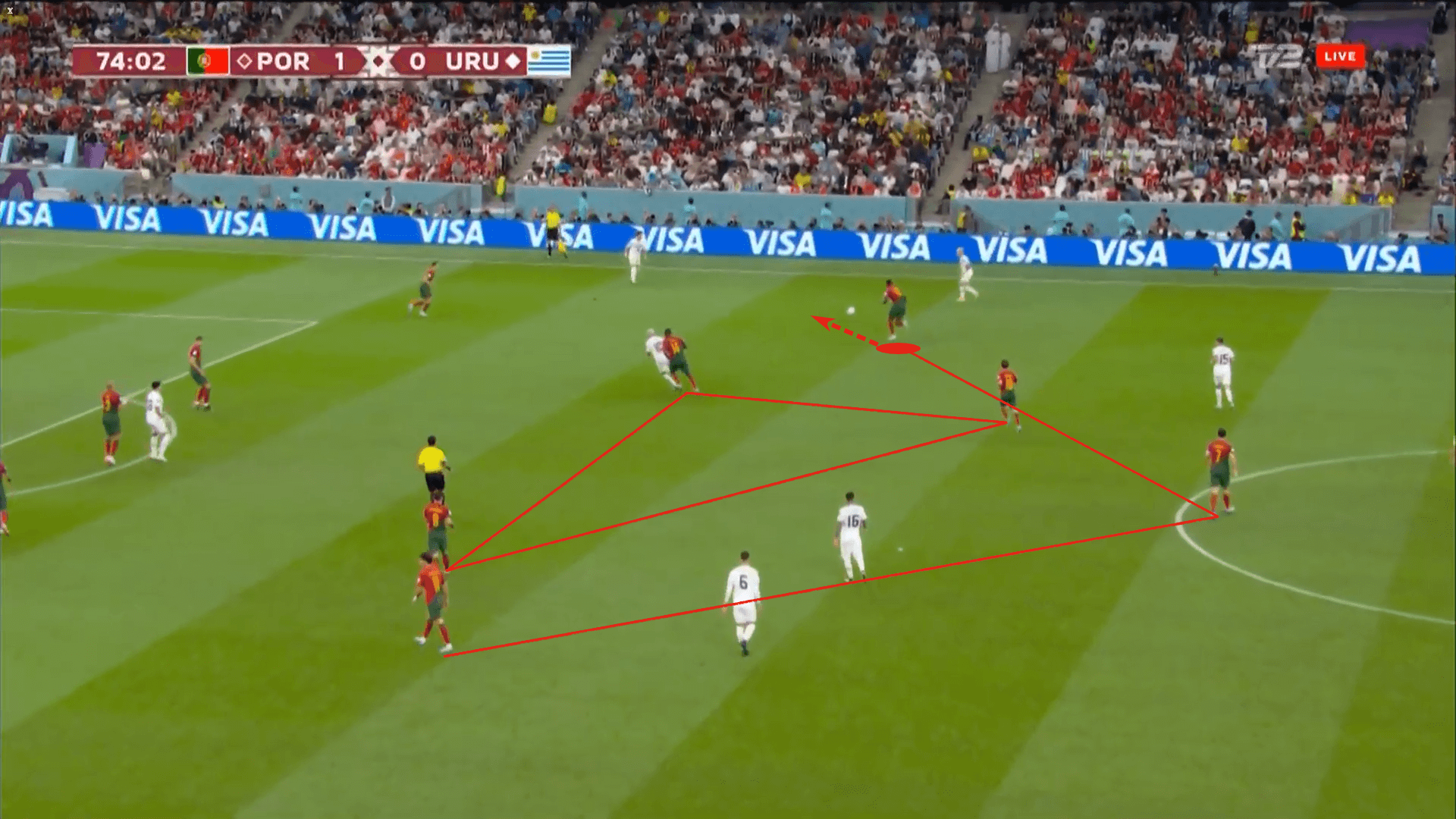
When Uruguay was able to get behind the outside backs, they would create a high central overload to get numbers into the box. In this sequence, only a fine defensive header by Cancelo prevented the South Americans from getting a close-range shot on target late in the match.
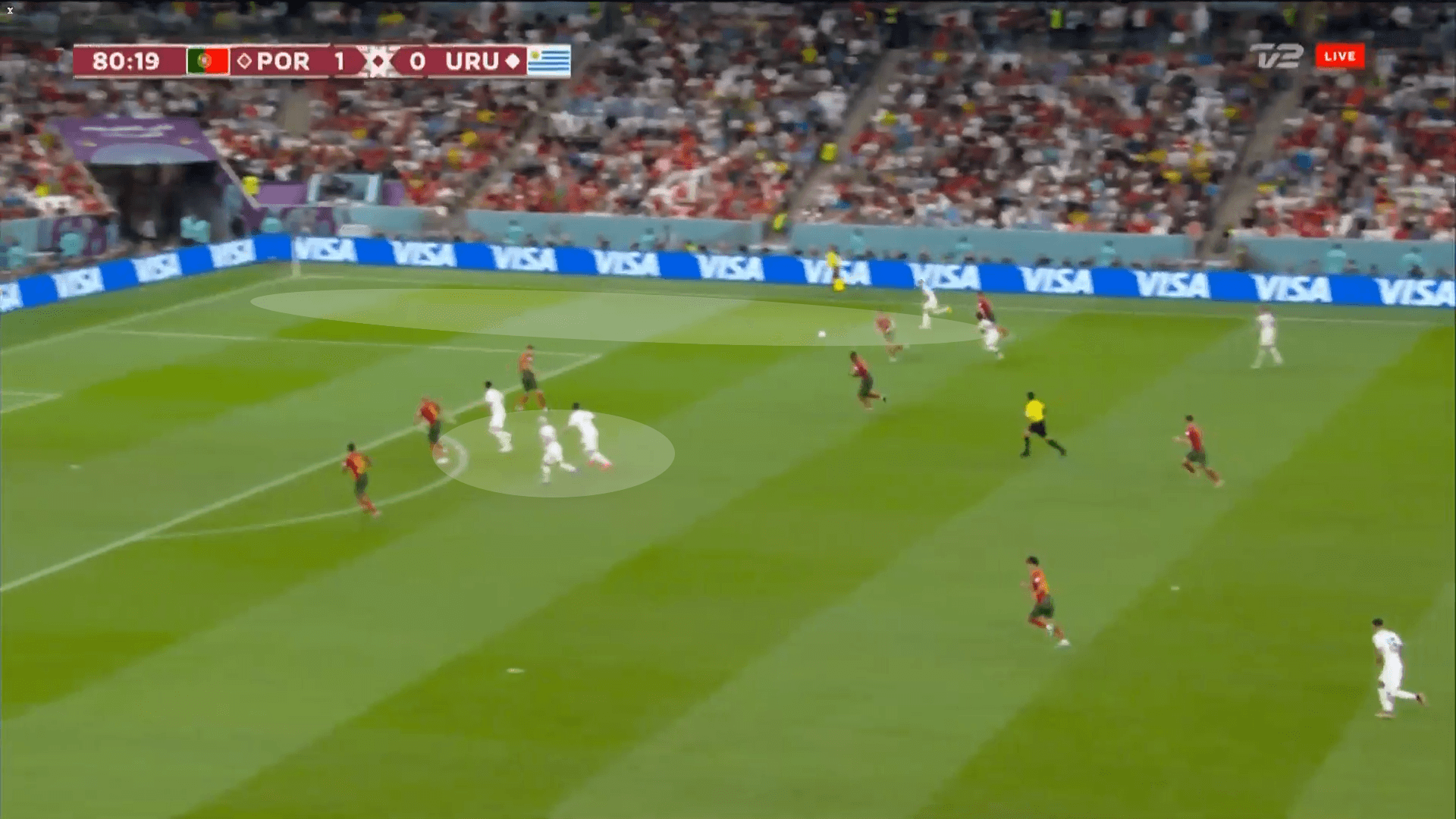
Uruguay managed to hit the post as well. It started from an attack in the wings that led to a 3v3 attacking scenario that freed Pellistri to receive between the Portuguese lines and hammer a first-touch shot past the diving Costa.
Uruguay looked more dangerous both in open play and transition. With the two wide midfielders and the two forwards often stepping into the highest line, Portugal received less support from the fullbacks higher up the pitch. As the Portuguese midfield fatigued just before the 80th minute, Uruguay produced another golden opportunity that would have tied the game. The sequence started with La Celeste receiving between the lines, creating a 5v4.
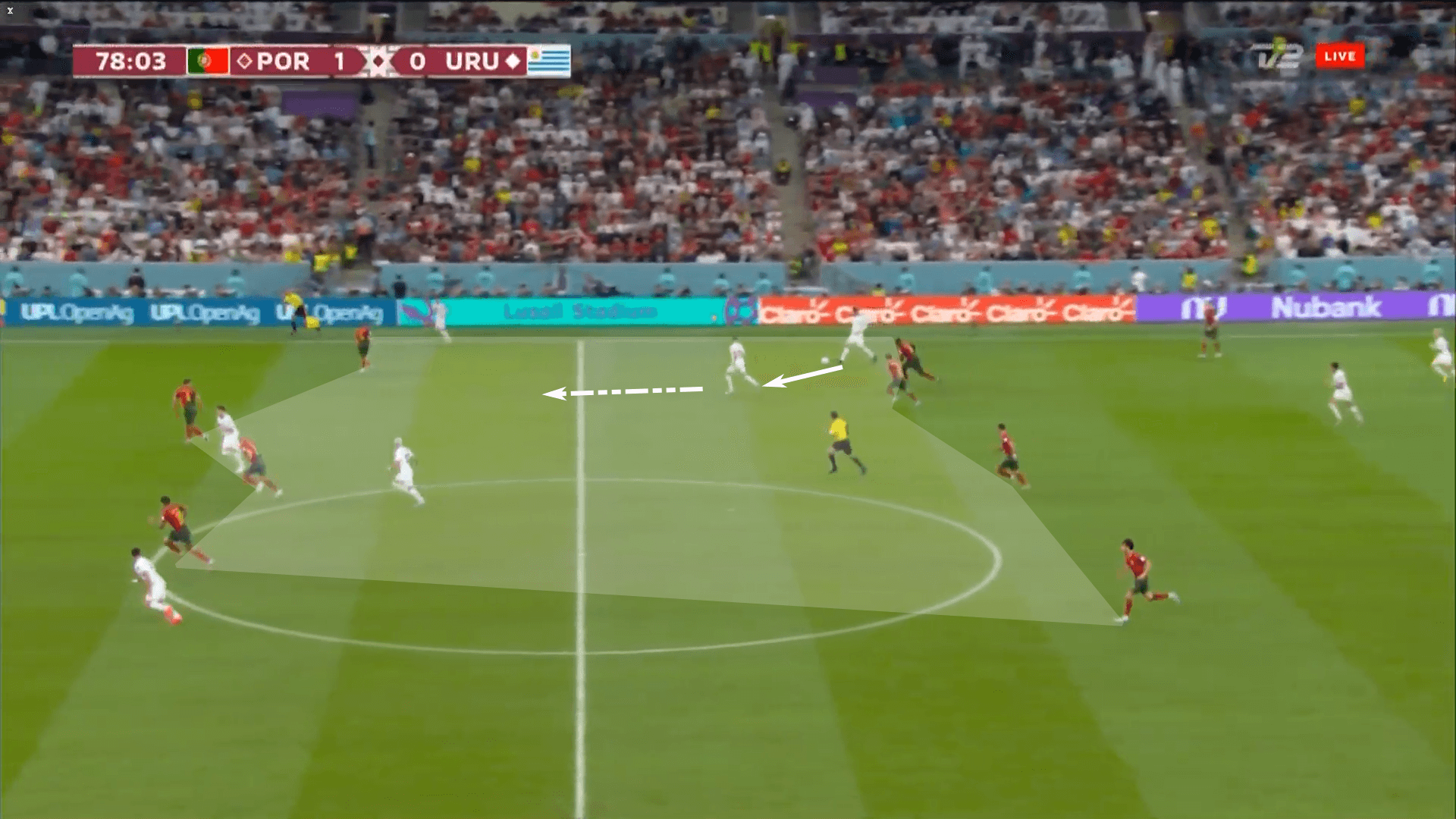
The Real Madrid star, Valverde, played an exquisite through ball onto the feet of Giorgian de Arrascaeta, who tried to chip Costa. Again, it was the Portuguese goalkeeper making an exceptional save to preserve both the clean sheet and the three points.
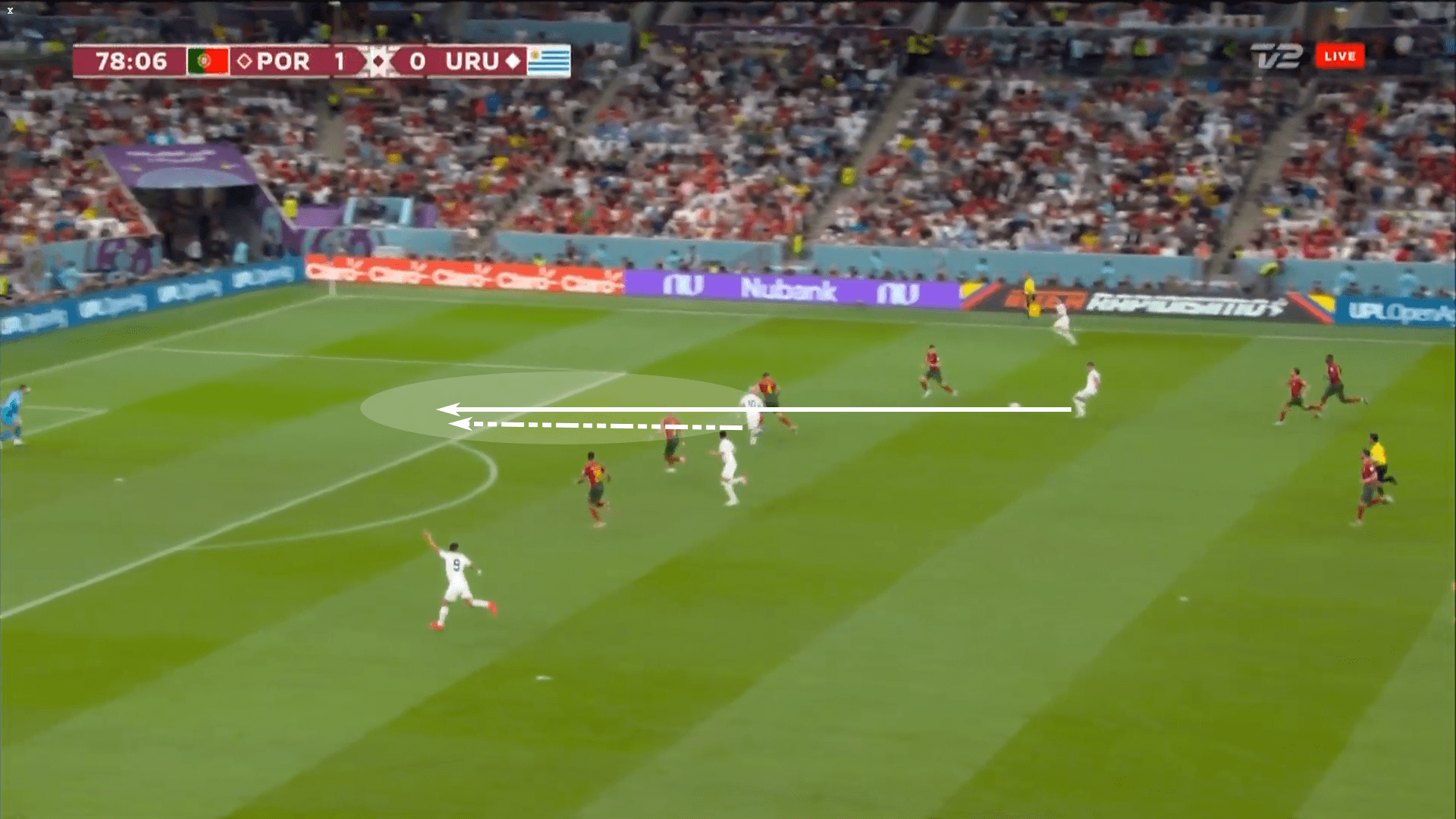
Not a moment too soon, Santos responded with a tweak to his tactics and fresh legs in midfield. Carvalho and Silva came off the pitch in favour of João Palhinha and Matheus Nunes. The two recently made their moves to the EPL over the summer, but the two seasons prior, they were at Sporting Clube de Portugal, helping lead the Lions to their first Primeira Liga title in 19 years. Their chemistry showed in this match, as they were able to help Portugal settle the game down and see out the result. It was the order to the chaos that Portugal desperately needed after Uruguay switched to the 4-4-2.
Portugal continued to press in a 4-3-3 high up the pitch but then showed some tactical versatility to drop into a 4-4-2 when in the mid-block. The highest line was passive in their approach, more focused on shadow-marking the Uruguayan midfield than applying pressure on the centre-backs. Overall, the tactical adjustment worked.
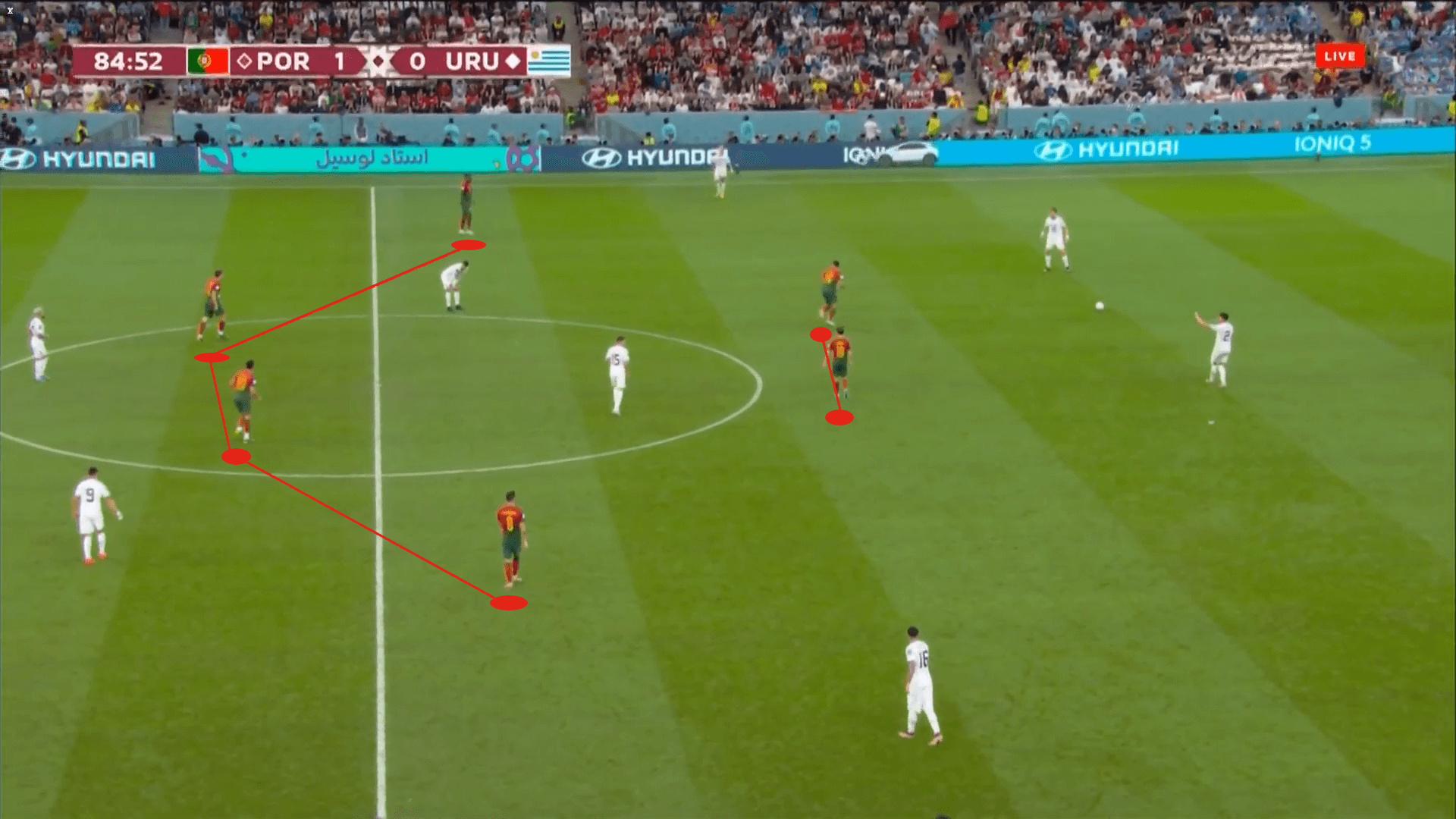
Portugal was able to add a second goal on a controversial penalty call, but it was Uruguay’s switch to the 4-4-2 that set the tone during the final 25 minutes of play.
Conclusion
Despite the 2-0 scoreline, it was another nail-biter for the Portuguese, whose fans were already short on nails following the ending against Ghana. Fortunately for the squad and the fanbase, the three points against Uruguay secured support for Portugal’s passage to the knockout rounds. All that is left to decide is their seeding.
For Uruguay, they must now win against Ghana and potentially get some help from Portugal against South Korea in order to secure their spot in the round of 16. Many would have predicted three or four points at this stage for the South American nation with a population of 3.4 million people, but they go into the final match of the group stage with just one. Only a win can get them through and it will have to come against a very good Ghanaian side.
Alonso’s experimental tactics didn’t doom the team in this match, but it must be said Uruguay played much better once they moved to a 4-4-2. Expect a more familiar system against Ghana and the lesson to be learned.

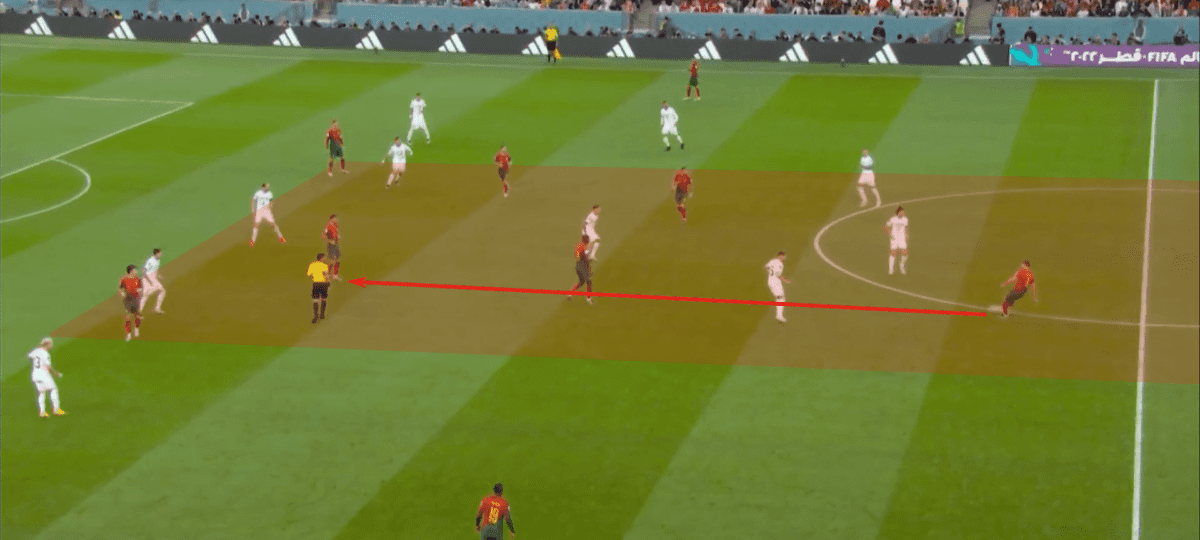



Comments